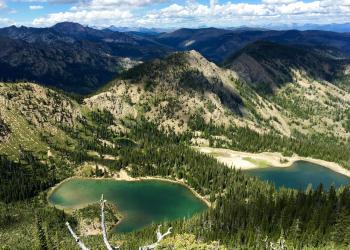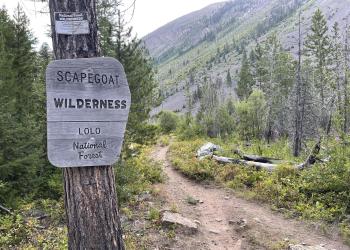Wilderness
The Lolo National Forest include four congressionally designated Wilderness Areas covering nearly 150,000 acres.
Wild by Law
The United States was the first country designate wilderness areas through law. When the Wilderness Act was passed in 1964, our nation's leaders formally acknowledged the immediate and lasting benefits of wild places to the human spirit and fabric of our nation. That year, in a nearly unanimous vote, Congress enacted landmark legislation that permanently protected some of the most natural and undisturbed places in America and provided a framework for designating additional wildlands.
Wilderness is untrammeled, undeveloped, primeval, unimpaired and natural. It is affected primarily by forces of nature, with man’s work substantially unnoticeable. It provides outstanding opportunities for solitude and primitive and unconfined recreation.
From the Wilderness Act:
Definition of Wilderness
(c) A wilderness, in contrast with those areas where man and his own works dominate the landscape, is hereby recognized as an area where the earth and its community of life are untrammeled by man, where man himself is a visitor who does not remain. An area of wilderness is further defined to mean in this Act an area of undeveloped Federal land retaining its primeval character and influence, without permanent improvements or human habitation, which is protected and managed so as to preserve its natural conditions and which (1) generally appears to have been affected primarily by the forces of nature, with the imprint of man's work substantially unnoticeable; (2) has outstanding opportunities for solitude or a primitive and unconfined type of recreation; (3) has at least five thousand acres of land or is of sufficient size as to make practicable its preservation and use in an unimpaired condition; and (4) may also contain ecological, geological, or other features of scientific, educational, scenic, or historical value.
Welcome Creek Wilderness

Located in the Rock Creek drainage east of Missoula, this nine-by-seven-mile wilderness offers steep ridges, narrow valleys, and amazing forests that are the home of a rich wildlife population. Finding a tent spot can be a challenge in this steep valley, but even in this small pocket of wilderness you can find solitude.
Rattlesnake National Recreation Area & Wilderness

Rugged peaks, winding trails, and alpine lakes, in Missoula's backyard. The southern boundary of the Rattlesnake National Recreation Area and Wilderness is four miles north of Missoula. The elevation varies from 3,600 feet at the NRA entrance to 8,620 feet on McLeod Peak.
Selway-Bitterroot Wilderness

The Selway-Bitterroot Wilderness is the third largest wilderness in the lower 48, and adjoins the Frank Church-River of No Return Wilderness at the Magruder Corridor Road, a narrow dirt track that is the only road for miles north and south. It straddles the Bitterroot Range across the Montana-Idaho Border, and lies in several national forests, including a small part within the Lolo.
Scapegoat Wilderness

Together, the Great Bear Wilderness, the Bob Marshall Wilderness and the Scapegoat Wilderness form the Bob Marshall Wilderness Complex, an area of more than 1.5 million acres. The western half of the Scapegoat is on the Lolo National Forest, bounded on its eastern side by the Continental Divide and Scapegoat Mountain, the tallest mountain in the complex at 9,214 feet.


